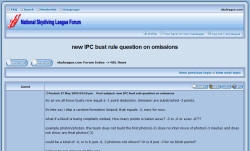
National
Skydiving
League
226 Pecan Street
Deland FL 32724
tel: (386) 801-0804
© 2003 - 2025
All Rights Reserved


226 Pecan Street
Deland FL 32724
tel: (386) 801-0804
© 2003 - 2025
All Rights Reserved


"So as we all know busts now equal a -1 point deduction. Omission are substracted -3 points. So lets say i skip a random formation Unipod, that equals -3, easy for now. What if a block is being completely omitted, how many points are taken away? -3 or -6 or even -9??? Example photon/photon, the team does not build the first photon(-3), does no inter move of the block (-3 maybe) and does not show any final photon(-3). could be a total of -9, or is it just -6, two photons not shown? Or is it just -3 for no block, period? Curious to see answers on this one."
The answer seemed easy, and Elsinore GT's Steve Miller, the Forum's moderator, was on hand with the explanation: "Minus 6. The inter is not a scoring formation. Infractions on the inter are applied to the next drawn formation (in this case, the bottom of Block 11). There is also the anti-double bust rule, which, although not directly applicable given that no block was ever started whether correctly, incorrectly or otherwise, the rule's principles may be followed. Accordingly, max penalty could only be minus 6. I am not a judge, but I do play one on t.v."
| 2.10. Scoring formation: is a formation which is correctly completed and clearly presented either as a random formation or within a block sequence as depicted in the dive pool, and which, apart from the first formation after exit, must be preceded by a correctly completed and clearly presented total separation or inter, as appropriate. |
Veteran judge Klaus Wellens, who has already answered and commented several judging issues for the NSL News in the past, confirmed Miller's conclusion:
"First of all you have to read the rules completely, not only parts of it. You have to know what a Scoring Formation is. A Scoring Formation is only a correctly completed formation, preceded by a total separation or a correct inter, except the very first exit formation. So I cannot give a penalty to an inter that is not followed by a point.
For an omission you do not get the point, because you never showed it, and you get a 3-point deduction. For an omitted random formation you do not get the point and a deduction of 3 points. For a completely omitted block you lose the 2 points and get a 6-point deduction (-3 for each omitted formation).
If you show point one of a block and omit the inter and you show point 2 of that block: you don’t get point 2 of the block because you did not show the correct inter and you get a 3-point deduction because of the omission. It is not so difficult to understand, I hope. I tray to make rules easy and I hope the changes this year is the beginning of it."
It was a clear answer from a top level judging official. However, the NSL News was wondering how the "Canadian Skydiver" could have possibly understood the written rules in a different way and challenged the easy conclusion.
The separate definition of the "omission" is defined in 2.12 of the IPC rules:
| 2.12. Omission is one of the following: 1) A formation or inter missing from the drawn sequence 2) No clear intent to build the correct formation or inter is seen but another formation or inter is presented and there is an advantage to the team resulting from the substitution. |
According to this paragraph of the rules, it does not seem to be so far from the truth if a reader would understand that there could be three different omissions in a whole block:
1. The omission of the first block formation 2. The omission of the inter 3. The omission of the second block formation
In fact, it seems to be obvious that the two formations of the block do not count as scoring formations, according to 2.10 of the IPC rules. After that, 2.12 defines that there is a 3-point deduction for each omission, no matter where the omissions are and how many of them.

The same counts for the omission. There is no part of the rules where the omission of an inter is directly or somehow connected to the second formation of a block. It can only be assumed that this connection is an interpretation of the rules for the infringement of an inter, which effects the second formation of the block.
The result of this "Canadian option" for the omission of a whole block would be devastating for the team. First and second formation of the omitted block do not count as scoring formations, 3-point deduction for the missing first formation, 3-point deduction for the missing inter, 3-point deduction for the missing second formation, for a total deduction of nine points.
The discussion is practically meaningless. Even only a 6-point deduction for an omitted whole block does not really make it an option for a team to gain an advantage. The slowest omitted block together with the fastest random sequence would not make up for the 6-point deduction on each page. The 3-point deduction for an omission seems to be enough to hold off any team from intentionally leaving out a block.
The discussion can be continued at the NSL Forum. Thanks to Canada for bringing up the issue.